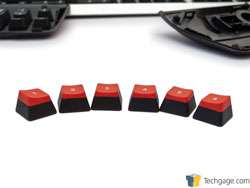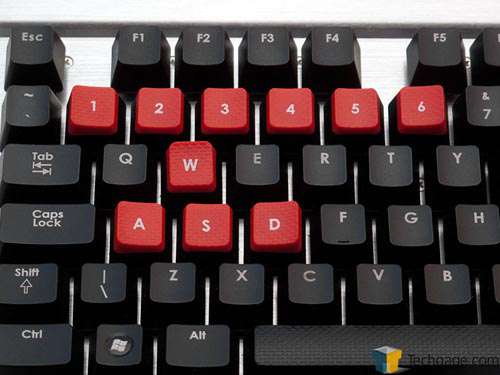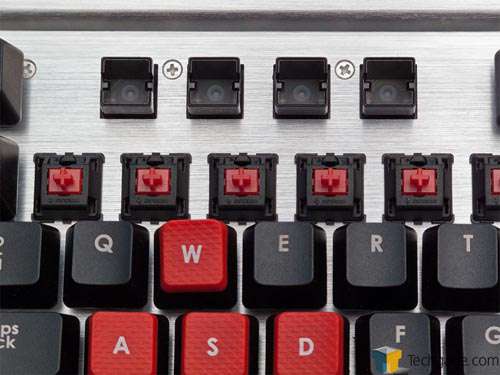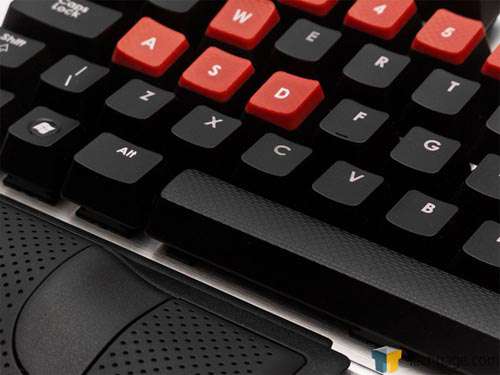- Qualcomm Launches Snapdragon 4 Gen 2 Mobile Platform
- AMD Launches Ryzen PRO 7000 Series Mobile & Desktop Platform
- Intel Launches Sleek Single-Slot Arc Pro A60 Workstation Graphics Card
- NVIDIA Announces Latest Ada Lovelace Additions: GeForce RTX 4060 Ti & RTX 4060
- Maxon Redshift With AMD Radeon GPU Rendering Support Now Available
Corsair Vengeance K60 Mechanical Keyboard Review
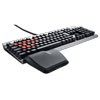
When Corsair releases a new product line, it’s never for a “me too” reason. Instead, the company clearly strives to deliver interesting products that people, especially gamers, crave. The Vengeance line-up of keyboards and mice is no exception, and we’re kicking off our coverage of them with the K60 mechanical keyboard.
Page 2 – Cherry Keys and Final Thoughts
The vast majority of keyboards out in the wild use rubber dome keys. They’re simple, cheap, mass produced and just ‘work’. Keyboard breaks? Get a new one, without batting an eyelid. Rubber domes are one of the reasons we have $5 keyboards. They’re also the reason for a lot of RSI in the world.
As a rubber dome key ages, it becomes stiff. Pressing keys becomes harder, causing more strain on the fingers. The contacts also wear out and don’t register properly, meaning you have to press harder still.
For typists, rubber domes might as well be touch screens; even if you feel the dome connect, it may not register due to its spongy nature. For gamers, the key needs to be pressed all the way down for it to register… those are valuable milliseconds wasted and a perceived loss of reaction time.
Mechanical keys and the Cherry MX series have a highly-prized value amongst enthusiasts. They’re highly durable switches that change the way a standard keyboard both feels and performs. However, there are different types of mechanical switches, each with their own benefits and compromise. So to clear things up, I’ll give you a quick rundown of the different types and why Corsair has gone with the MX Red keys.
There are 4 switch types in the Cherry range, going from Blue, Brown, Black and Red. Blue and Brown are the traditional non-linear ‘typist’ switches which have the mid-way ‘bump’ for feedback’. Brown is the lighter switch of the two, requiring less pressure to activate. Blue has the very audible ‘click’ (popular with typists, not for coworkers). Black and Red keys are linear in their action, so feedback is minimal and no bump to overcome before activation. Black keys are stiffer and cheaper, while Red requires the least effort to push. So for gaming, the ‘best’ switch is Red, due to no feedback, linear and minimal activation – but they’re rare in a full keyboard and cost a bit more too.
What Corsair has done then is bring a very rare switch type to the market while keeping the price and feature set very competitive. Though, as we’ll find out later, “best for gaming” is not “best all round”. So with a little clarity on the switch types, let’s get back to the K60.
The replaceable keys that come with the K60 are rubberized, textured (faint diamond pattern) and contoured. W, A, D, 1 and 6 all have lips on their edges for easier finger placement, and they do their job well. But the same contour and lips do pose a small issue when typing, and it does take a little getting used to them at first. If you look at the next photo though, something else does seem at odds.
Notice something missing? No? Look closer. There are no symbol markings on the numbers. Now, if you’re a regular typist, this is not a major issue, you’ll know the symbols off by heart. It’s those unfamiliar who will inevitably stumble trying to find # or %, at least corrections a few backspaces away.
As stated on the previous page, not all the keys on K60 are MX Reds; some are in fact the more traditional rubber domes. There are a number of reasons for this, but the easiest one to understand is cost. These Red keys are not cheap (all mechanical switches aren’t cheap to begin with), so outfitting the entire board with them would be silly, since not all keys are put through the same level of wear. All the F keys, plus Esc, Print Screen, Scroll Lock, Pause/Break and the Insert, Page Up block, are all rubber domes. Apart from cost, another reason for this is that of accidental key presses.
Due to the difference in feel between the rubber and Red switches, it’s easy to tell when you press the wrong button. Trying to find the ~ key for Push-to-Talk, and end up hitting Esc instead? Well, now you’ll know. If your little finger gets a little too energetic and hits Del instead of Enter, you’ll feel it. The interesting thing to note is that since the rubber dome keys need to be pressed all the way down to activate, you can stop yourself mid-press.
So how does the keyboard perform under gaming conditions? Extremely well in all honesty. I have been using rubber dome keys in one form or another all my life. In the last 5 years, I’ve spent most of my time on the shallow – laptop style key-sets, just to reduce the strain on my hands. The K60 was in fact my first real hands on experience with a mechanical keyboard. Browsing websites and such about the benefits of a mechanical keyboards over more traditional keys often point to their superior durability. It’s not just that the keys will last 50 times longer than a normal keyboard, but how they behave and what impact they will have on your typing and gaming.
With the MX Red keys specifically, they are very effective when it comes to gaming. No sooner as the neural chemistry of your brain instructs your finger to move, it begins to press the key and it’s already registered by the computer. The lightest of touches can activate a key, and you really do notice this.
I play a lot of games, I’m not ashamed to admit that. The immediate difference in my reaction times was actually quite astonishing. Double-tapping becomes easier, reactive abilities in MMOs become instant. There is still an initial force to overcame, so it’s not as if breathing on a key will activate it, but these are definitely some of the lightest keys I’ve come across – and the fastest to respond to input. After 6-10 hour days at a keyboard, the only strain I have is on my elbows (I need a new chair) and the odd nag in my right hand from the mouse.
Now, what makes these keys extraordinary for gaming, also make them difficult for typing. If you have an even slightly sloppy typing style and tap other keys by mistake, those will register. These Red keys really do force you to become a little more concise and accurate with your typing, less you find yourself staring at a minefield of additional characters. So be prepared to spend more than a couple weeks getting used to the feel of the board.
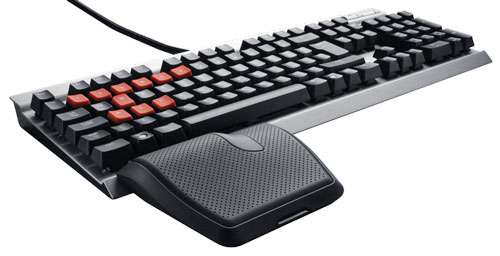
There is one other problem that surfaces every now and then, and it’s something that affects both the K60 and K90. That’s key locking or streaming, depending on what you call it. It’s when a key is released and it continues to act as if it’s still pressed. The only way to stop it is to press the key again. This seems more of a mechanical issue with the switches than a firmware issue – due to the sensitive nature of the keys. It doesn’t happen often, but over the last 3 weeks, it’s occurred about 7 or 8 times. However, it’s not happened at all this last week, so it may just be the keys settling in.
So the question comes – would I buy one? Definitely. As a gaming keyboard, it’s exemplary. It picks up on those twitch reflexes extremely well and it makes going back to a standard keyboard difficult. It is a challenge to type on, so if you’re looking for a best of both worlds, this isn’t it. For a straight-up reflexive FPS gaming keyboard, this is a winner. You may miss out on the extended macro support and back-lighting on the K90 MMO-based keyboard, but that’s fine. I don’t need to see the keyboard when I’m killing anything that moves. As it is, the Corsair K60 is an easy Editor’s Choice. Now go forth and frag.

Corsair Vengeance K60 FPS Mechanical Keyboard
Discuss this article in our forums!
Have a comment you wish to make on this article? Recommendations? Criticism? Feel free to head over to our related thread and put your words to our virtual paper! There is no requirement to register in order to respond to these threads, but it sure doesn’t hurt!
Support our efforts! With ad revenue at an all-time low for written websites, we're relying more than ever on reader support to help us continue putting so much effort into this type of content. You can support us by becoming a Patron, or by using our Amazon shopping affiliate links listed through our articles. Thanks for your support!





